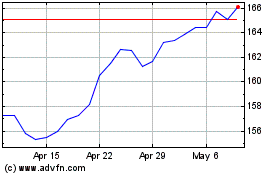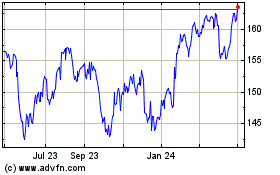Unilever Gets More Than a Name in Dollar Shave Club
July 20 2016 - 8:20AM
Dow Jones News
LONDON—Unilever PLC's $1 billion deal to buy Dollar Shave Club
is the consumer-goods giant's latest effort to get a leg up on
rivals in the fight for customer data.
Dollar Shave Club's direct-to-consumer model—through which it
sells disposable razors and other grooming products to 3.2 million
members—will give Unilever "unique consumer and data insights,"
said Kees Kruythoff, Unilever's North America president, in the
company's deal announcement early Wednesday.
The acquisition gives Unilever a foothold in the U.S. shaving
market, where Dollar Shave Club has been stealing share from
Procter & Gamble Co. unit Gillette. That trend could accelerate
under Unilever's deep-pocketed ownership. It is also in line with
Unilever Chief Executive Paul Polman's strategy to shift Unilever
toward home and personal-care products and away from slow-growing
foods.
More important, Unilever's decision to buy the unprofitable
Venice, Calif., startup gives it further ammunition in the war to
harness a burgeoning wave of online data. Companies have been
mining customer data online for years, but the race to better
understand shoppers has heated up as executives grapple with
quickening change. Unilever is facing a growth threat from
Amazon.com Inc., which has been expanding in traditional Unilever
strongholds such as laundry detergents and tea, as well as with a
host of local startups.
In response, Unilever is getting smarter.
The company collects data on 100 million people, allowing it to
target products or advertising specifically for them. It listens to
about 200,000 conversations by scraping the internet.
Unilever has test-launched an online portal in India connecting
shoppers with the plethora of small, physical stores that carry
products from Unilever and others.
Unilever runs the site, Humarashop, but local stores fulfill and
deliver orders. By playing middleman—often for products that aren't
even its own—Unilever gets access to customer data it then uses to
refine the promotions it lists on Humarashop.
E-commerce currently makes up just 1% of Unilever's global
sales, but grew 50% last year.
Gathering local customer insights helps Unilever stay relevant
in various regions, said Alan Jope, Unilever's president of
personal care, at a June conference. "We're increasingly capturing
huge amounts of information about what really matters to our
consumers and feeding these insights virtually and real time to our
global and local marketing teams," he said.
After online data collection helped it deduce that 2016 was
going to be the year of the "messy bun"—a hairstyle in which women
messily pile hair atop their heads—Unilever embarked on a
guerrilla-marketing campaign, paying or helping bloggers to create
video tutorials on how to create the look. The bloggers
incidentally used an array of Unilever products, such as TRESemmé
hair spray and Dove dry shampoo.
In an interview earlier this year, Stan Sthanunathan, Unilever's
senior vice president of consumer and market insights, said the
company looks for "the words that bubble up to the top" on Google
and for things that have "substantial volume." Unilever likes
analyzing customer conversations online because it gets less
contrived responses, he added.
Unilever noticed that people discussed dandruff more in the
winter, leading the company to put more money into advertising its
"Clear" range of products during the season.
Trawling through customer data also helped Unilever decide to
advertise ice cream brands such as Magnum before it rains. The
Anglo-Dutch company discovered that on rainy days in the U.K.,
people like to stay at home, eat ice cream and watch movies.
Changing the timing of its ads has helped sales, it said.
Write to Saabira Chaudhuri at saabira.chaudhuri@wsj.com
(END) Dow Jones Newswires
July 20, 2016 08:05 ET (12:05 GMT)
Copyright (c) 2016 Dow Jones & Company, Inc.
Procter and Gamble (NYSE:PG)
Historical Stock Chart
From Mar 2024 to Apr 2024

Procter and Gamble (NYSE:PG)
Historical Stock Chart
From Apr 2023 to Apr 2024
